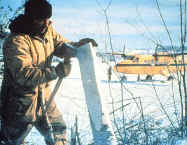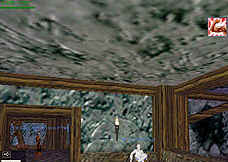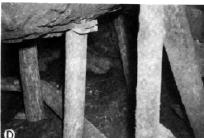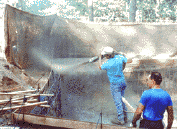| Gallery - A horizontal or a
nearly horizontal underground passage, either natural or artificial. |

|
| Gasification – Any of
various processes by which coal is turned into low, medium, or high Btu gases. |
|
| Gathering conveyor; gathering belt
- Any conveyor which is used to gather coal from other conveyors and deliver it either
into mine cars or onto another conveyor. The term is frequently used with belt conveyors
placed in entries where a number of room conveyors deliver coal onto the belt. |
|
| Geologist - One who studies
the constitution, structure, and history of the earth's crust, conducting research into
the formation and dissolution of rock layers, analyzing fossil and mineral content of
layers, and endeavoring to fix historical sequence of development by relating
characteristics to known geological influences (historical geology). |

|
| Geology - a science dealing
with the formation of the earth and ore deposits. |
|
| Gob - The term applied to that
part of the mine from which the coal has been removed and the space more or less filled up
with waste. Also, the loose waste in a mine. Also called goaf. |
 |
| Global climate change –
This term usually refers to the gradual warming of the earth caused by the greenhouse
effect. Many scientists believe this is the result of man-made emissions of greenhouse
gases such as carbon dioxide, chlorofluorocarbons (CFC) and methane, although there is no
agreement among the scientific community on this controversial issue. |
|
| Grade - the value of an ore |
|
| Grain - In petrology, that
factor of the texture of a rock composed of distinct particles or crystals which depends
upon their absolute size. |
 |
| Grizzly - Course screening or
scalping device that prevents oversized bulk material form entering a material transfer
system; constructed of rails, bars, beams, etc. |
 |
| Ground control - The
regulation and final arresting of the closure of the walls of a mined area. The term
generally refers to measures taken to prevent roof falls or coal bursts. |

|
| Ground pressure - The pressure
to which a rock formation is subjected by the weight of the superimposed rock and rock
material or by diastrophic forces created by movements in the rocks forming the earth's
crust. Such pressures may be great enough to cause rocks having a low compressional
strength to deform and be squeezed into and close a borehole or other underground opening
not adequately strengthened by an artificial support, such as casing or timber. |
|
| Grout - a filling agent
inserted by pressure into loose and broken rock or ground |
|
| Gunite - A cement applied by
spraying to the roof and sides of a mine passage. |

|